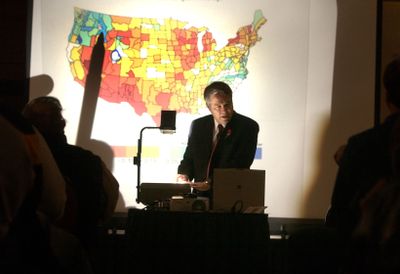Forecaster warns of long dry spell
Wheat farmers hear two-year prognistication by ‘the Weatherman’

Eastern Washington should brace for two years of dry weather.
November’s rainy patterns will continue until February, an expert forecaster said Friday, but the region’s precipitation levels will drop significantly by March.
And it’ll stay relatively dry outside until May, Art Douglas – known as the “the Weatherman” by farmers – told wheat growers Friday.
Douglas, a retired environmental and atmospheric science department chairman from Creighton University in Omaha, Neb., has been delivering some of the most reliable long-range forecasts for 30 years. Farmers often consider his information when deciding what to plant.
Temperatures for the winter and spring will be average – perhaps even a bit warmer than usual, Douglas said.
For farmers, already struggling with poor crops and declining grain prices, Douglas’ predictions for a dry spring and summer seemed to fall right in line with troubled times.
“If you thought you had problems last year,” Douglas said, “this is a real cause of major concern for you folks.”
While growers should get the rain they need in May and June to produce decent crops, Douglas said, there’s a 40 percent or greater probability of an El Niño next summer, which points to a warmer – and “critically dry 2010” – in the region.
Without an El Niño, wheat farmers enjoyed a terrific 2007, when high crop prices and good yields delivered profits. They were looking for another good year in 2008, but erratic weather left many with small harvests and poor grain quality.
And as the stock market began to sink, the price of soft white wheat tumbled. Farmers were caught because they had already bought and used high-priced fuel and fertilizer to grow the crops. There will be little if any return on that investment this year.